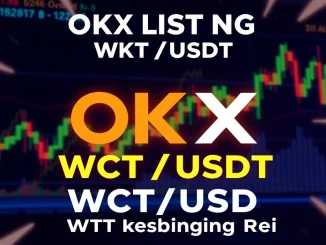
A significant event just hit the crypto news wires: a massive 500,000,000 USDT transfer. This substantial movement, reported by blockchain tracking service Whale Alert, saw the large sum move from a wallet associated with the decentralized finance (DeFi) protocol Aave to the cryptocurrency exchange HTX. Valued at approximately $500 million, this large crypto transaction immediately captured the attention of market observers and participants alike. When a crypto whale makes such a move, it often triggers speculation about their intentions and potential market impact.
What Does This USDT Transfer Signify?
The core of the news is the movement of a vast amount of Tether (USDT), the largest stablecoin by market capitalization. A 500 million USDT transfer is not an everyday occurrence, even in the fast-paced world of crypto. Its origin from Aave and destination at HTX are key details providing context.
- Scale: $500 million is a considerable sum, capable of influencing liquidity and trading dynamics, particularly on a specific exchange.
- Origin (Aave): Aave is a leading DeFi protocol where users can lend or borrow crypto assets. Funds held on Aave are typically earning yield or being used as collateral. Moving funds *from* Aave suggests the owner is taking assets out of a DeFi lending/borrowing position.
- Destination (HTX): HTX (formerly Huobi) is a major centralized cryptocurrency exchange. Moving funds *to* an exchange often indicates an intention to trade, sell, or consolidate assets for other purposes available on a trading platform.
This specific USDT transfer is a clear example of a large crypto transaction that warrants investigation into potential motives.
Understanding Aave and HTX in This Crypto Whale Move
To fully appreciate the significance of this transfer, it helps to understand the platforms involved.
Aave: Aave is a non-custodial liquidity protocol. Users supply crypto assets to liquidity pools to earn interest or borrow assets against their collateral. It’s a cornerstone of the DeFi ecosystem, focused on decentralized lending and borrowing without intermediaries.
HTX: HTX is a centralized cryptocurrency exchange offering spot trading, derivatives, and other crypto services. Like other major exchanges (Binance, Coinbase, etc.), it acts as a central hub for buying, selling, and exchanging various cryptocurrencies.
The movement of such a large amount of USDT from a DeFi lending platform (Aave) to a centralized trading platform (HTX) suggests a shift in strategy by the owner of these funds. It’s a transition from a yield-generating or collateralized position in DeFi to a position potentially aimed at trading or increasing liquidity on an exchange.
Why This Large Crypto Transaction Matters
Tracking large cryptocurrency movements, especially those involving a crypto whale, provides valuable insights into market sentiment and potential future activity. While a single transaction doesn’t dictate the market’s direction, large transfers can:
- Signal Intent: Moving large sums to exchanges can precede significant buying or selling activity.
- Impact Liquidity: Injecting $500 million onto an exchange can increase the available liquidity for trading pairs involving USDT.
- Influence Sentiment: Large, unexplained moves can sometimes create uncertainty or fuel rumors, impacting short-term market sentiment.
- Highlight Trends: Observing flows between DeFi protocols like Aave and centralized exchanges like HTX can reveal broader trends in how large players are utilizing different parts of the crypto ecosystem.
This 500M USDT transfer is a prime example of the kind of on-chain activity that analysts watch closely.
Potential Reasons Behind the Aave to HTX USDT Transfer
Pinpointing the exact reason behind this specific 500M USDT transfer is impossible without direct knowledge of the wallet owner’s plans. However, based on typical crypto whale behavior and the platforms involved (Aave and HTX), several possibilities exist:
- Preparing for Trading: The most common reason to move significant funds to an exchange is to facilitate trading, either buying other assets or potentially selling the USDT for fiat or other cryptocurrencies.
- Increasing Exchange Liquidity: The owner might be a market maker or institution looking to increase their USDT balance on HTX to support trading operations.
- Exiting a DeFi Position: The funds might have been used as collateral on Aave, and the owner decided to repay a loan or simply withdraw their principal from the lending pool.
- Consolidation: The owner might be consolidating funds from various sources, including their Aave position, onto a single exchange for easier management.
- OTC (Over-The-Counter) Trading: Large block trades often occur off-exchange but might require funds to be present on an exchange wallet before or after the deal.
Each potential reason carries different implications for the market. A move to sell could add selling pressure, while a move to buy could indicate bullish intent. Without further information or subsequent transactions, it remains speculative.
Tracking Crypto Whales: An Actionable Insight
For regular market participants, tracking reports like the 500M USDT transfer from Aave to HTX by services like Whale Alert offers an actionable insight: awareness. While you can’t know the whale’s exact motive, being aware of large fund movements helps you understand where significant capital is flowing. It encourages looking deeper:
- Are other large transfers happening concurrently?
- What is the market sentiment like around the time of the transfer?
- Does subsequent price action align with potential motives (e.g., does the price of BTC or ETH rise or fall after the transfer to the exchange)?
This awareness is part of building a comprehensive view of the market, combining on-chain data with technical and fundamental analysis.
In conclusion, the reported 500M USDT transfer from Aave to HTX is a notable large crypto transaction. It highlights the scale of capital moving within the crypto ecosystem and the interplay between DeFi protocols and centralized exchanges. While the specific reasons for this crypto whale’s action remain unknown, tracking such significant USDT transfer events provides valuable data points for anyone navigating the cryptocurrency markets.



